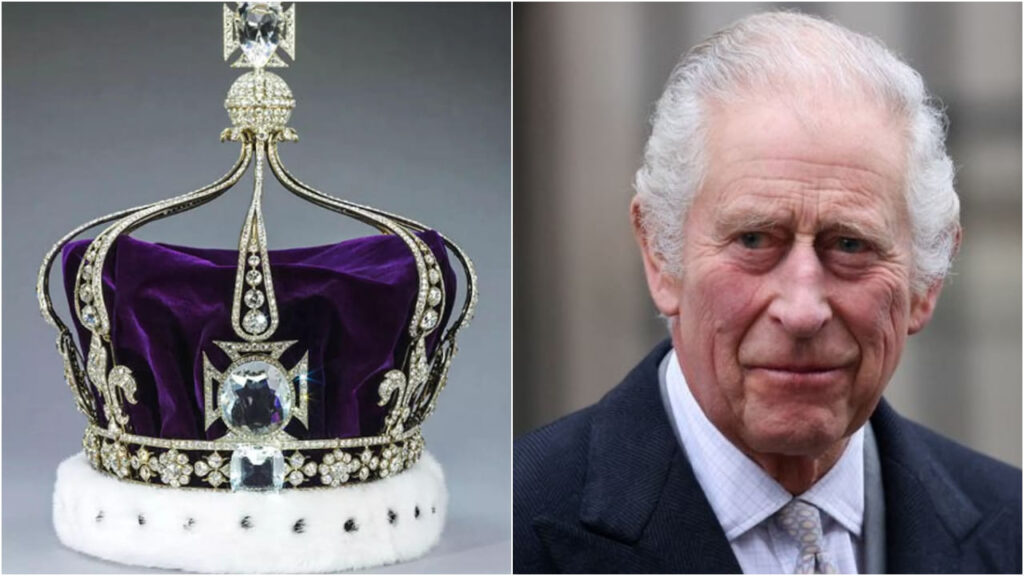News Desk, Kolkata : The Koh-i-Noor, possibly the world’s most famous diamond, weighing 105.6 carats, was plundered from India by the British colonial rulers. Currently adorning the British royal crown, the diamond’s name in Persian translates to ‘Mountain of Light.’ Yet, its history is intertwined with a dark curse. It is believed that this renowned gem brings misfortune to its male owners. After the death of Queen Elizabeth II, the curse seemingly struck again when it was inherited by King Charles III, who later faced the adversity of cancer.
The saga of Koh-i-Noor dates back to the Golconda mines in Kollur, discovered during the Kakatiya dynasty. It emerged as an alluring gem among rulers, leading to conflicts over its possession. In 1628, Mughal Emperor Shah Jahan incorporated the diamond into the majestic Peacock Throne, a symbol of opulence adorned with various gems, including the Koh-i-Noor. However, unrest accompanied its presence within the Mughal Empire.
Through a series of battles, Koh-i-Noor changed hands multiple times. Nader Shah of Persia, after defeating Nadir Shah, claimed the diamond as part of his spoils. Eventually, it fell into the hands of Maharaja Ranjit Singh of Punjab in the early 19th century. The British East India Company, in 1849, during the annexation of Punjab, took possession of Koh-i-Noor, adding it to the British Crown Jewels.
The diamond’s journey continued as the British monarchy faced challenges during the Indian Rebellion of 1857. The British Crown weathered the storm, but the story of Koh-i-Noor remained an unsettling chapter. The British royals, particularly male heirs, were said to be cautious about the curse associated with the diamond.
To evade the curse, the British royal women, starting with Queen Victoria, adopted the tradition of wearing Koh-i-Noor only during significant ceremonies. Successive queens like Alexandra and Elizabeth II continued this practice. After Queen Elizabeth II, the crown passed to King Charles III, who, unfortunately, battled cancer, fueling speculations about the curse’s influence.
Despite public awareness and demands from India for the diamond’s return, the British monarchy has not taken any steps to repatriate Koh-i-Noor. The narrative echoes the historical tug-of-war between the colonial past and the demands for restitution in the present. The question lingers: Will King Charles III reconsider the fate of Koh-i-Noor in light of his health challenges?
In recent times, the debate over the return of cultural artifacts and treasures has gained momentum globally. Various countries are urging the restitution of items taken during the colonial era. Koh-i-Noor stands as a symbol of this complex issue, sparking discussions on rightful ownership and historical justice.
As we delve into the 21st century, the allure of Koh-i-Noor persists. Queen Victoria’s tiara, adorned with the infamous diamond, is displayed in the Tower of London. The British royal family remains tight-lipped about the potential repercussions of the diamond’s curse.
In the face of the ongoing discourse surrounding cultural repatriation, the Koh-i-Noor continues to be a focal point. The British monarchy’s handling of this matter could set a precedent for addressing historical grievances. Will the curse of Koh-i-Noor influence the decisions of the British royal family in the years to come? Only time will reveal the unfolding chapters of this captivating tale, where the brilliance of a diamond is shadowed by the weight of its history and the echoes of an ancient curse.
DISCLAIMER
Our news media denounces any form of bias and disapproves of sensationalism. The disseminated news is entirely educational and aimed at social awareness. Our media maintains absolute impartiality, adhering solely to the purpose of education and social consciousness.


